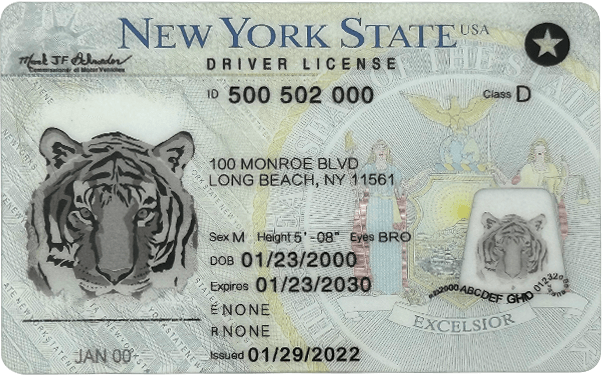In an era where security and authenticity verification are of utmost importance, the detection of fake driver’s licenses has become a crucial aspect of maintaining order and safety in transportation – related systems. As technology continues to evolve, so does the sophistication of fake documents, making it imperative for detection methods to keep pace.
Current State of Fake Driver’s License Detection
Currently, various techniques are employed to detect fake driver’s licenses. Visual inspection is one of the most basic methods. Authorities look for signs such as poor – quality printing, misaligned text, or inconsistent coloration. However, with the advancement of printing technology, counterfeiters are becoming more skilled at mimicking the appearance of genuine licenses.
Another common method is the use of ultraviolet (UV) light. Many driver’s licenses have UV – sensitive features, such as hidden images or fluorescent fibers, that are visible only under UV light. This helps in quickly identifying whether a license is genuine or not. Additionally, magnetic stripe readers and barcode scanners are used to verify the information encoded on the license. These readers can check for the correct format and authenticity of the data stored on the magnetic stripe or barcode.

Biometric technology has also made its way into driver’s license detection. Fingerprint scanners, for example, can be used to match the fingerprint on the license with the individual presenting it. This adds an extra layer of security, as biometric data is unique to each person.
Challenges in Current Detection Methods
Despite the existing detection methods, there are several challenges. One major challenge is the increasing sophistication of counterfeiting techniques. Counterfeiters are using high – end printing equipment and advanced materials to create fake licenses that are difficult to distinguish from real ones through visual inspection alone. They may also replicate UV – sensitive features, making it harder to rely solely on UV light for detection.
Another challenge is the global nature of the problem. Different countries have different driver’s license designs and security features. This makes it difficult to develop a universal detection system. For example, some countries may have more advanced security features than others, and counterfeiters may target the weaknesses in less – secure license designs.

Furthermore, the speed of detection is also a concern. In busy environments such as border crossings or vehicle inspection stations, authorities need to quickly verify the authenticity of driver’s licenses without causing long delays. The current methods may sometimes be time – consuming, especially when multiple checks are required.
Emerging Technologies for Future Detection
Artificial Intelligence and Machine Learning
Artificial intelligence (AI) and machine learning (ML) are expected to play a significant role in the future of fake driver’s license detection. These technologies can analyze large amounts of data from genuine and fake licenses. By training AI and ML models on a vast dataset of real and counterfeit licenses, these systems can learn to recognize patterns and features that are characteristic of fake documents. For example, they can detect subtle differences in font styles, image quality, or the placement of security features that may not be apparent to the human eye.
AI – powered systems can also adapt to new counterfeiting techniques. As counterfeiters develop new methods, the ML models can be updated with new data to improve their detection accuracy. This adaptability makes AI and ML a powerful tool in the fight against fake driver’s licenses.
Blockchain Technology
Blockchain technology has the potential to revolutionize driver’s license verification. Blockchain is a decentralized and immutable ledger that can store and verify information. Driver’s license data can be stored on a blockchain, making it extremely difficult to tamper with. When a license is presented for verification, the system can quickly check the blockchain to confirm its authenticity. This eliminates the need for central – ized databases that are vulnerable to hacking and data manipulation.
Moreover, blockchain can provide a transparent and auditable record of license issuance, renewal, and any changes made to the license information. This can help in detecting any unauthorized modifications to the license data, which is a common problem with fake licenses.
Advanced Imaging Technologies
Advanced imaging technologies such as 3D imaging and hyperspectral imaging are also on the horizon for fake driver’s license detection. 3D imaging can capture the physical shape and texture of a driver’s license, which can be unique to genuine licenses. Counterfeit licenses may not have the same 3D characteristics, and this can be used to identify them.
Hyperspectral imaging, on the other hand, can analyze the chemical composition of the materials used in the license. Different materials, such as paper, ink, and laminates, have distinct spectral signatures. By analyzing these signatures, hyperspectral imaging can detect if the materials used in a license are consistent with those of a genuine one.
Implementation and Integration of Future Technologies
Implementing these emerging technologies will require careful planning and integration. For AI and ML systems, large – scale data collection and pre – processing are necessary to train the models effectively. This data needs to be sourced from various regions and license types to ensure comprehensive coverage.
Integrating blockchain technology into the existing driver’s license infrastructure will require cooperation between different government agencies and stakeholders. Standardization of data formats and protocols is essential to ensure seamless communication between different blockchain – enabled systems.
Advanced imaging technologies need to be incorporated into portable and user – friendly devices. This will allow for on – the – spot verification of driver’s licenses in various environments, such as traffic stops or border control points. Additionally, training programs will be required to ensure that law enforcement officers and other relevant personnel are proficient in using these new technologies.
Common Problems and Solutions
- Problem: False Positives
With the use of advanced detection technologies, there is a risk of false positives, where a genuine license may be flagged as fake. This can cause inconvenience to the license holder and waste the time of the authorities.
Solution: To reduce false positives, AI and ML models can be fine – tuned with more accurate and diverse training data. Additionally, multiple detection methods can be used in combination. For example, if an AI system flags a license as potentially fake, it can be further verified using biometric or visual inspection methods to confirm the result.
- Problem: Compatibility with Existing Systems
Implementing new detection technologies may face challenges in terms of compatibility with existing driver’s license management systems. For example, integrating blockchain may require significant changes to the current data storage and retrieval mechanisms.
Solution: A phased approach can be adopted for implementation. First, conduct pilot projects to test the new technologies in a controlled environment and assess their compatibility with existing systems. Then, develop standard interfaces and protocols to ensure seamless integration. This may also involve working with software vendors to update or modify existing systems to support the new technologies.
- Problem: Cost of Implementation
Adopting new and advanced detection technologies such as AI, blockchain, and advanced imaging can be costly. This includes the cost of purchasing equipment, software development, and training personnel.
Solution: Governments and relevant agencies can explore cost – sharing models with private partners. For example, technology companies may be willing to invest in the development and implementation of these technologies in exchange for certain incentives or long – term contracts. Additionally, cost – benefit analysis can be conducted to justify the investment in the long run, considering the potential savings from reduced fraud and improved security.
- Problem: Privacy Concerns
Biometric and other personal data collected during the license verification process may raise privacy concerns among the public. There is a risk of data breaches or unauthorized use of this sensitive information.
Solution: Strong data protection and privacy policies need to be in place. Encryption techniques should be used to safeguard personal data, and access to this data should be strictly regulated. Additionally, public awareness campaigns can be launched to educate the public about the importance of these security measures and how their data will be protected.
- Problem: Resistance to Change
Law enforcement officers and other personnel may be resistant to learning and using new detection technologies. This can slow down the adoption and effectiveness of these technologies.
Solution: Comprehensive training programs should be developed to familiarize personnel with the new technologies. These programs should be designed in an interactive and user – friendly manner, with hands – on training and real – life scenarios. Incentives can also be provided to encourage personnel to embrace the new technologies, such as career advancement opportunities or performance – based rewards.
Fake ID Pricing
unit price: $109
| Order Quantity | Price Per Card |
|---|---|
| 2-3 | $89 |
| 4-9 | $69 |
| 10+ | $66 |



